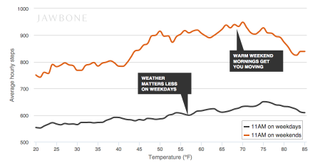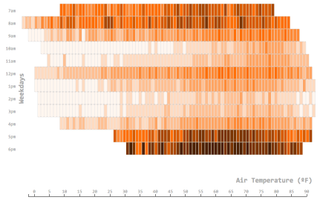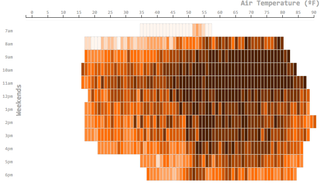People Move Less in Extreme Weather, Jawbone Tracker Finds

When the weather outside is frightful, people tend to move around less, according to new data from Jawbone, a technology and fitness-tracking company based in San Francisco.
The company looked at data posted online over the course of a year by people in the U.S. wearing the Jawbone UP fitness tracker, and found that on weekdays, users walked 5 percent more steps when the temperature was 70degrees Fahrenheit (21 degrees Celsius) than they did when it was 40 F (4 C). However, on weekends the number of steps people take increases by 15 percent across the board, according to a post on the company's blog.
"There is an ideal temperature range for physical activity," Eugene Mandel, a member of Jawbone's data team, wrote in a Nov. 19 blog post. "People move more when the temperature is comfortable. Activity reaches its peak in the range of the low 60s to high 70s degrees Fahrenheit [15 to 26 Celsius]."

Hundreds of thousands of people across the U.S. now wear the Jawbone UP, a wristband that tracks its users' movements, sleep patterns and healthy living goals, the company says. Users can upload their data online, and the company's data science team mines it for information and trends.
For this most recent analysis of the role that outside temperature plays in people's activity levels, the company used data from the National Climate Data Center, and matched each UP wearer's step count to the outside weather in their area, from May 2013 to May 2014. [Best Fitness Tracker Bands]
The results support the idea that people tend to move less during extremely hot or cold weather.
The data showed that during the weekdays, most people take more steps in the early morning or evening, as opposed to the middle of the day. And most people commute to work no matter the temperature, racking up hundreds of steps. But they still move less than they do on the weekends, when more people go to the gym or out for a run.
Sign up for the Live Science daily newsletter now
Get the world’s most fascinating discoveries delivered straight to your inbox.

Outside temperature also plays a big role in people's weekend activity levels. People's number of steps generally increases with temperature, and most people move more in the morning, the data showed.
But regardless of the day, people tend to move more when the temperature is between the low 60s and high 70s, Mandel said.

The finding has several limitations. The Jawbone researchers only looked at daytime waking hours of UP users in the continental U.S., so they discounted the night owls who exercise when it's dark outside. Moreover, people who wear fitness trackers are likely to be more affluent and exercise more than the average American.
This isn't the first time Jawbone has provided insightful data on its users. In August, just after a 6.0-magnitude earthquake hit South Napa, California, the majority of its UP users woke up at 3:20 a.m. if they were within 15 miles of the epicenter, the company found.
Follow Laura Geggel on Twitter @LauraGeggel. Follow Live Science @livescience, Facebook & Google+. Original article on Live Science.

Laura is the archaeology and Life's Little Mysteries editor at Live Science. She also reports on general science, including paleontology. Her work has appeared in The New York Times, Scholastic, Popular Science and Spectrum, a site on autism research. She has won multiple awards from the Society of Professional Journalists and the Washington Newspaper Publishers Association for her reporting at a weekly newspaper near Seattle. Laura holds a bachelor's degree in English literature and psychology from Washington University in St. Louis and a master's degree in science writing from NYU.
